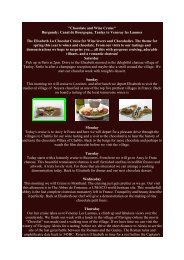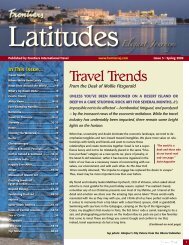You also want an ePaper? Increase the reach of your titles
YUMPU automatically turns print PDFs into web optimized ePapers that Google loves.
The Challenge: Don’tblame Peter Mayle, of A Year in <strong>Provence</strong>notoriety: The southeasternmost corner ofFrance has never been short of visitors. Itscobalt Luberon Mountains, seductive coastline,rippling lavender fields, and honeystonehilltop villages have inspired everyonefrom Nostradamus to Van Gogh. TheRomans settled in <strong>Provence</strong> in the secondcentury b.c.; even the Vatican transplantedhere from dazzling Rome in the fourteenthcentury. In fact, given its extraordinary historyand bewitching natural beauty, youmight call <strong>Provence</strong>’s popularity a self-fulfillingprophecy. (You were right, Nostradamus!)Coming here presents the visitor withtwo problems: how to edit 12,124 squaremiles, six départements, and a whole season’sworth of attractions—from markettowns to world-famous vineyards—intojust seven days, and how to see it more orless solo, leaving the tourist hordes behind.The Solution: Unless sittingRenault bumper to Renault bumper onmelting highways is your idea of fun, forget<strong>Provence</strong> in high summer. The French are awise race: More than any other Europeancitizens, they take their summer vacationsin their own backyard (why would they wantto go anywhere else?), which means endlesslines in July and August as well as the usualprice hikes at restaurants, hotels, and museums.The French have two months toburn, so they can afford to sit in traffic—you can’t. Come October, the crowds disperseand you’ll practically have those hilltopvillages and bistros to yourself. Andsince the mercury can soar to the mid-90sin summer, a bit of froideur, if you will, couldmake your explorations all the more pleasurable.Second, be realistic and take yourtime. You can’t cover the entire region in aweek, nor would you want to. Experiencingla vraie <strong>Provence</strong> is about lengthy foie gras–laden lunches (vegetarians, look away now)as much as it is about scoping out medievalchurches and Roman ruins. For a fail-safesolution, engage the services of an expertsuch as Jill Jergel of <strong>Frontiers</strong> InternationalTravel, who visits the region annually andknows which restaurants are in favor withthe local gourmets, what time the Romanesquecloisters at Aix’s Cathédrale St-Sauveurare unlocked, which hotels have greatlooks and superlative service, and how tosecure backstage tours of Châteauneuf-du-Pape cellars. Together, we designed a magnifiqueitinerary that took in the three A’s:Aix, Arles, and Avignon; skipped the swankyseaside Côte d’Azur in favor of low-key Cassis;dipped down to the rugged Camarguein the deep south; and included one-off experienceslike a balloon ride, dinner at achef’s table, and, turning the tables, acooking class—it was the least one coulddo after all that gorging.IDay 1 (Saturday): Aix-en-<strong>Provence</strong>t’s a.m. on Saturday and you’re breakfasting likeLe Roi René himself in the ornate dining room ofthe Villa Gallici (33-4-42-23-29-23; doubles, $520–$60),Aix-en-<strong>Provence</strong>’s best hotel, having arrived on the TGVfrom Paris the previous evening and bedded down inyour wonderfully chintzy room, where the aroma oflavender virtually guarantees a good night’s sleep. Thebreakfast spread includes mocha coffee in a silver pot,croissants and pain au chocolat, a row of homemadejams like bright daubs of paint, yogurt, and apple puree,all served on rosebud china. Will you ever be satisfiedwith a Starbucks and a muffin again? It’s an appropriateintroduction to <strong>Provence</strong>—a region where eatingoften seems more important than breathing—and setsthe scene for a gastronomic week.After, be sure to leave the hotel no later than 9 a.m.,armed with a map from reception. Make your waysouth into the center of Aix—it’s a 15-minute stroll.Aix-en-<strong>Provence</strong> (population 141,000) is to France whatBoston is to the United States. It’s an elegant, aristocraticcharmer with the quintessential plane tree–linedboulevard, the Cours Mirabeau; handsome seventeenth-centuryhôtels (elegant town houses); and seductivemini-squares with gurgling fountains. Foundedby the Romans in 123 b.c., Aix was the capital of<strong>Provence</strong> from the twelfth century until the Revolution.It has been a university town for centuries, and luminariesof the literary and art worlds—Zola, Cézanne,In Place Richelme, FOLLOW YOUR NOSE,and the arthritic ladies pushing shoppingcarts, to a table overflowing with 15 types ofmushrooms, including orange-tinted girollesHemingway—found inspiration here. It’s no accidentthat you’ve come on a Saturday in fall: This is Aix’s premiermarket day, and October is a monthlong harvestfestival, so you’re heading for the Place de l’Hôtel deVille, with its vivid array of blooms, and then the PlaceRichelme, for kaleidoscopic vegetables. On your way,you pass the Cathédrale St-Sauveur (you’ll return later),on the rue Gaston de Saporta, and stop in at theConfiserie du Roy René (13 rue Gaston de Saporta; 33-4-42-26-67-6) to buy calisson candies [Fig. 1]. But don’tdawdle: The vendors pack up in the early afternoon.At the Place de l’Hôtel de Ville, you’ll see tightbunches of roses in six different hues ofpink, ornamental cabbages, lilies, andblousy sunflowers, the yellow-stone Hôtelde Ville providing an elegant backdrop. Atthe petite Place Richelme, the vegetablemarket unfurls under the plane trees that characterizethis town and the region—they wereplanted on the orders of Napoleon, to shade histroops on the way to battle. Here, you’ll findmany of the sweet and savory delights that will end upon your plate this week: fromage de chèvre and saucisson,rosy-red coeur de boeuf tomatoes, streaky purpleand white eggplant, jars of honey in shades of amber.There are bundles of <strong>Provence</strong>’s most famous export,lavender, which also comes in little pillows—great soporificsouvenirs, an instant Proustian recollection fromyour trip. Next stop, the Place des Prêcheurs for olive oiland tapenade, herbes de <strong>Provence</strong>, and the season’smust-buy: fungi. The markets have everything youcould possibly need for the perfect Provençal picnic,so pick up choice morsels of cheese and salami (samplingbefore you buy, naturally) and a baguette andthen stash your haul in your rucksack for later. Skipthe brocante (flea market) part of the Place des Prêcheurs—it’sfallen victim to panpipers, polyester versions[Fig. 1]Calissons, a centuries-oldiced marzipancandy in theshape of petals, aremade from groundalmonds and fruitand are native to Aix.JULY 201047
[Fig. 13]Wednesday is marketday in the prettytown of St- Rémy,and the stalls spillinto the boulevardsand squares of theold town.juice; the sauce is thickened with agar-agar. Next, welearn to scale and debone the sea bass, then stuff it withtapenade and fennel, season, sauté, and bake with adash of stock, while the figs are stewed in red wine withcinnamon leaves and honey. You scoff the results in thedining room with your fellow amateur chefs.Leave Domaine de Valmouriane by 2 p.m. for the driveback to St-Rémy, where you’re spending the afternoon.Pay a visit to legendary chocolatier Joël Durand (3 blvd.Victor-Hugo; 33-4-90-92-3-25), just off the main square.Durand, who opened his first boutique at the age of 19,infuses his chocolates with a radical array of spices. Next,walk to the Musée Estrine (33-4-90-92-34-72), in a handsome174 stone house in the heart of the old town. Themuseum is worth a visit for its collection of 20 works byAlbert Gleizes, on the second floor. Gleizes lived in St-Rémy from 1939 until 1953; hewas, with Picasso, Braque, andLéger, one of the most importantFrench Cubists, and the paintingshere chart the evolution ofhis style from Impressionistlandscapes to splashy, upbeatCubist works. The ground floorhouses an homage to St-Rémy’smost famous son, or inmate,Vincent Van Gogh, in the form of reproductions of manyof his paintings—sadly, there are no original works.In May 19, Van Gogh admitted himself to theMonastère St-Paul-de-Mausolée (Route des Baux; 33-4-90-92-77-00), an asylum on the outskirts of town, aftertaking a razor to his ear in Arles. Despite, or becauseof, his fragile mental state, the year he spent here wasone of his most productive—Van Gogh painted StarryNight and many self-portraits and landscapes at theMonastère and in the countryside (he was permitted towalk an hour from the asylum). It’s your next stop (unlessyou have an urge to stretch your legs, skip the VanGogh walk from town to the clinic, with yet more reproductionsof works, and drive). As a museum, the Romanesquebuilding is somewhat wanting—the descriptionsof the artist’s time here and of the barbaric treatmentspatients were subjected to, tacked to the walls, are convolutedand confusing—but the building itself is stunning.It’s easy to summon the ghost of Van Gogh andSkip the pre-Roman remains at Glanum, south ofSt-Rémy. They’re nothing compared with THEBEAUTIES YOU’LL SEE AT ARLES, whichinclude an amphitheater and full baths complexJULY 2010imagine him gazing melancholically out at the mutedProvençal landscape from the window on the secondfloor, or wandering dejectedly among the lavender andancient apricot trees outside—and to marvel at how theartist and his madness transformed these soft shadesinto vibrant, urgent, graphic canvases.Be sure to leave St-Rémy no later than five o’clockfor the 30-minute drive to France’s Wild West. Thechange in scenery as you head south on the D36 isastounding: Mountain ranges give way to the bleak,flat land of the Camargue, a marshy delta betweenthe Mediterranean and the two branches of theRhône that feels like another continent. Your base,for one night, is the Mas de Peint (33-4-90-97-20-62;doubles, $29–$374). A stone farmhouse with eightrooms that are simply but tastefully furnished (unlikethe full-on-crazy chintz of your previous two lodgings),it’s on a 1,300-acre estate owned by the Bon family. Dinneris booked for p.m., so when you’ve checked in, hada dip in the pool, and showered, head back along theD37 to Chez Bob (Mas Petite Antonelle, Route SambucVilleneuve Gageron; 33-4-90-97-00-29; prix fixe, $50), ina cozy farmhouse built in 1610. Bob arrived here in 193,planning to stay a week; we’re lucky he never left, becausehis anchoïade (an anchovy and garlic dip that’sslathered on crudités) and his maigret de canard andbull steak grilled over the flames in the dining room’singlenook fireplace are very good indeed, their unalloyedrustic flavors a huge contrast, like the landscape,to everything else you’ve eaten this week.YDay 6 (Thursday): The Camargueou’re heading deep into the Camargue this morning,so after breakfast, check out of your roomand meet your jeep driver in reception at 9 a.m. (If youdon’t speak fluent French, be sure to ask the receptionistto book you an English-speaking driver. Minedeclared that he spoke “pas d’un mot d’anglais,” andhis southern accent was, to my ears, as impenetrableas Glaswegian.) The jeep tour takes you deep into thispays sauvage punctuated with briny ponds—whencederives the region’s famous fleur de sel, or sea salt.You’ll see the black bulls native to the Camargue—they look like ink blots among the wind-whippedreeds and grasses—and your driver will tell youabout the ancient tradition of bullfighting, whichpersists today. Every village in these parts has itsown arena, and bullfighters begin training at theage of 14 at an école taurine, where they learn toswipe a piece of cotton from the bull’s head using aspecial comb. It’s a risky but lucrative sport: The winnergets about $1,000 a pop (“C’est le business!” said ourdriver). You’ll also see the Camargue’s trademark freeroamingwhite horses and some of its 400 bird species,including herons, and, if you’re lucky, flamingos. Theyounger members of the flamingo flock fly to thewarmer climes of North Africa in the fall, but a few oldiesremain; witnessing their ludicrously long, slightforms drift over the Étang de Vaccarès lagoon is quitean experience [Fig. 15].Back at the hotel, hop into your car and drive north onthe D36 to Arles. You’re exploring this Roman sparklerand UNESCO World Heritage Site on your own this afternoon,so after dropping off your car at Parking du Centre,head on foot across the boulevard des Lices and throughthe Jardin d’Été to the Théâtre Antique (33-4-90-1-41-20;hours vary). Chances are the theater will be closed, butdon’t worry: You get an uninterrupted view of this extraordinarilywell-preserved perfect semicircle, built at[Fig. 14]Chef Pascal Volle’sfirst lesson is on thedelicate art of artichokepreparation:You remove the outerleaves and thefuzzy core and leavethe heart and a fewinner leaves.55
ICONIC ITINERARIESP rovence[Fig. 15]The Camargue’s distinctivewild whitehorses are an ancient,hardy speciesthat are born blackor brown and graduallyblanch.[Fig. 16]Arles’s Roman amphitheaterstill fillsduring bull-fightingseason, and it’s extraordinaryhow littleits design differsfrom that of moderndayarenas.the end of the first century b.c., from outside. Then walknorth to Roman Arles’s pièce de résistance, the Amphithéâtre,designed by architect T. Crispus Reburrus(also responsible for Nîmes’s amphitheater), with a capacityof 20,000 [Fig. 16]. Climb the tower for a magnificentview of Arles and the Rhône River beyond. Next,stroll down the rue Raspail and turn left onto the rue duQuatre Septembre. (If you’re wondering why you keepfinding yourself on streets with this name, it’s becauseSeptember 4, 170, is the date on which France’s Third Republicwas established.) The ruedu Quatre Septembre leads tothe Baths of Constantine, whichare among France’s best preservedand are one of threesuch complexes in Arles. YourAmphithéâtre ticket is good forthe baths, too; be sure to pickup a mini guide at the entry kiosk—distinguishingthe tepidariumfrom the caldarium is tricky without it. The complex,a foundation of Roman social life where men andwomen of all walks of life would steam, splash, and socialize,was built during the reign of Emperor Constantinethe Great in the fourth century a.d. Much of thecompound remains unexcavated, but most of the intricateredbrick lattice–patterned frigidarium, tepidarium,caldarium, and laconicum (sauna) have been exposed,and you can see the brick stacks that formed the underfloorheating system. It should be about 2 p.m. by now—time to grab a quick lunch at one of the city’s cafés. Oneoption is the attractive Jardin des Arts (3 rue de la République;33-4-90-96-10-36; lunch entrées, $11–$24).After your meal, walk to the Église St-Trophime. Themost impressive parts of the church are the astoundinglydetailed Romanesque West Portal, on the Place de la République,and the Cloister, a complex built for the canons(priests who attended the bishop). You’ll recognize thesymbols of the Evangelists surrounding Christ on thetympanum of the portal from the cloisters you saw inAix’s Cathédrale St-Sauveur; even more extraordinaryis the army of carved saints below and the angelsabove. The peaceful cloister galleriesprovide another three-dimensional recapof the headliners of Christianity: Adepiction of the patron saints of the ÉgliseArles and of the Easter Mystery ison the north side; the Passion of Christand scenes from his life occupy the gallery’seastern side; the story of SaintTrophime, the patron saint of Arles,makes up the older southern gallery; and other popularbiblical stories are on the western side. Don’t miss thecollection of seventeenth-century tapestries (some ofthe world’s finest examples from that period), depictingscenes from battle and the story of Saint Trophime.Aim to leave Arles by five to drive to the hilltop villageof Gordes, on the edge of the Plateau de Vaucluse, via theN113, the A7 to Cavaillon, and then the D2. The trip willtake about two hours, so you should arrive in Gordes intime for sunset—and there aren’t many better vantagepoints in the whole region than your base for the last twonights, La Bastide de Gordes & Spa (33-4-90-72-12-12;doubles, $309–$574), on the edge of the village, directlyabove the Luberon Valley. That said, the hotel does haveits cons. The rooms, apart from the pricey suites, arenothing to write home about; the staff are less than effusive;and there are numerous added costs: The weak Wi-Fi is $26 per day (yes, really). The alternative is La Bastidede Marie (33-4-90-72-30-20; doubles, $71), amid vines,olive groves, and lavender fields between Gordes andBonnieux. It has bucketloads more charm: The guestrooms have wrought-iron four-poster beds, exposedbrickwalls, and claw-foot tubs. The catch here is that it’sa bit out of the way and the considerable rates are demipensione,meaning they include breakfast and dinner;Think the plains of Africa are the only place you’llspy flamingos? There are 30,000 in <strong>Provence</strong>’sWILD CAMARGUE REGION—their pinkcomplexion is due to their shrimp and plankton dietalthough the food is good, chances are you’ll want to explorethe area’s other culinary offerings. Speaking ofwhich, dinner tonight has been booked for p.m. atL’Estaminet (Place du Village; 33-4-90-72-14-45; entrées,$16–$31), a casual, inexpensive bistro a stone’s throwfrom La Bastide de Gordes.YDay 7 (Friday): The Luberonour last day in <strong>Provence</strong> will be spent exploringle paysage of the Luberon Valley. Be sureyou get up early, while the mist is hanging like ashroud over Gordes, buy a breakfast croissant fromthe boulangerie-pâtisserie on the rue de l’Église, oppositethe castle, and eat it in the shadow of the mightyramparts while you study the map and decide which ofFrance’s Plus Beaux Villages are most deserving of yourattention. There are so many gorgeous medieval hilltophamlets in the département of Vaucluse that you can’t gowrong whichever crop you choose—and since it’s Octoberand most travelers have dispersed, you won’t have touse your elbows to get that photo. But since you haveonly this morning—the afternoon will be spent toastingyour Provençal vacation plusieurs fois during an escortedwine tasting—plan which villages to hit before you setoff. One good option is a loop of three villages belowthe N900: Lacoste, Ménerbes, and Oppède-le-Vieux.Lacoste is crowned by a castle occupied by that notoriouspenner of filth, the Marquis de Sade, in the lateeighteenth century. It’s now owned by fashion designerPierre Cardin, who holds a music festival there everyJuly. To get to the castle, walk up the narrow cobbledrue St-Trophime and onto the rue de la Frescado; thenturn right and up the narrow chemin du Château to theruins (the estate was sacked by an angry mob in 179).The castle is surrounded by contemporary sculpture andlooks down on the village and as far as the medievalridgetop village of Ménerbes, four miles west [Fig. 17].Ménerbes was the setting for Peter Mayle’s A Year in[Fig. 17]Libertine writerthe Marquis de Sadeturned ancientLacoste castle into anX-rated fiefdom, andit was here that hewrote his magnumopus Les 120Journées de Sodome.56 CONDÉ NAST TRAVELER / cntraveler.com





